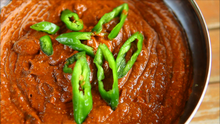Spicy soybean paste used in Korean cuisine
Ssamjang (Korean: 쌈장) is a thick, spicy paste used with food wrapped in a leaf in Korean cuisine. The sauce is made of fermented soy beans (doenjang), red chili paste (gochujang), sesame oil, onion, garlic, green onions, and optionally brown sugar.[1][2][3][4]
Etymology
Ssam means "wrapped" and jang means "paste" or "thick sauce". Together as ssamjang they mean "wrapping sauce".
Variations
Besides the standard way of making ssamjang, other ingredients can be added to make special versions.[5] There are also commercially prepacked ssamjang available on the market.[6]
- Nut ssamjang (견과류 쌈장): ground walnuts, pumpkin seeds, sunflower seeds, and other nuts are added
- Jjukumi ssamjang (쭈꾸미 쌈장): diced short-arm octopus is stir-fried with diced red peppers and onions, and mixed together with ssamjang
- Tofu ssamjang (두부 쌈장): crushed tofu is added
- Flying fish roe ssamjang (날치알 쌈장): flying fish roe is added
- Namul ssamjang (나물 쌈장): various beans are diced and added
- River snail ssamjang (우렁이 쌈장): boil the water with doenjang, river snail, green onion, garlic, and red pepper powder.[7]

